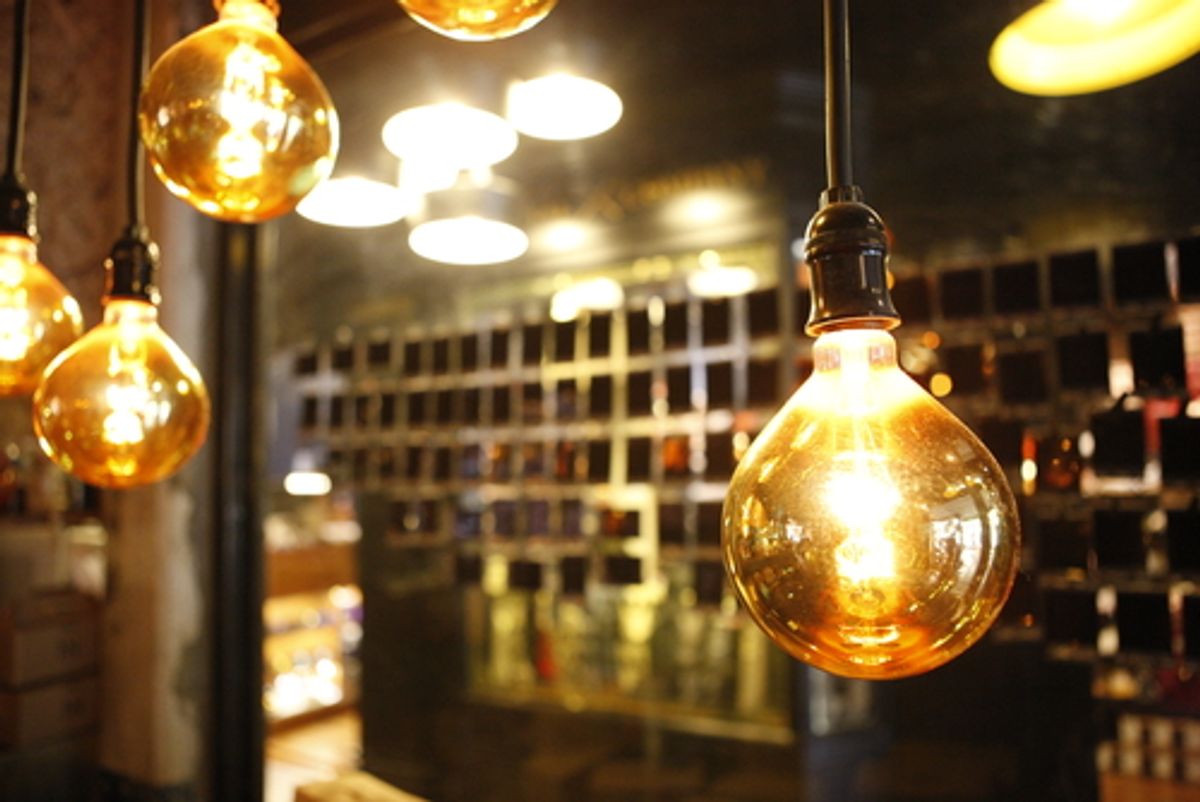 There are certain times when you want the lights turned way down low. One such time, according to recent research, is when you need to think creatively.
There are certain times when you want the lights turned way down low. One such time, according to recent research, is when you need to think creatively.
“Darkness increases freedom from constraints, which in turn promotes creativity,” report Anna Steidle of the University of Stuttgart and Lioba Werth of the University of Hohenheim. A dimly lit environment, they explain in the Journal of Environmental Psychology, “elicits a feeling of freedom, self-determination, and reduced inhibition,” all of which encourage innovative thinking.
Steidle and Werth describe six experiments which provide evidence for their thesis. The key one featured 114 German undergraduates, who were seated in groups of two or three in a small room designed to simulate an office.
The room was lit by a fixture hanging from the ceiling directly above the desk. The amount of illumination varied, with some groups receiving only 150 lux (dim light), others 500 lux (the recommended lighting level for an office), and still others 1,500 lux (bright light).
After acclimating themselves for approximately 15 minutes, participants went to work on what the researchers describe as “four creative insight problems typically used in creativity research. These tasks require that individuals change their perceptions of a given problem in order to find the optimal solution.”
After spending two minutes attempting to solve each problem, participants rated how free from constraints they felt. They noted the degree to which they felt externally controlled, and reported their level of self-assurance.
The results: Those in the dimly lit room solved significantly more problems correctly than those in the brightly lit room. They also felt freer and less inhibited than their intensely illuminated counterparts. Participants in the bright and the conventionally lit rooms did not differ significantly from one another on either scale.
“These results indicate that dim illumination heightens perceived freedom from constraints, which in turn improves creative performance,” the researchers conclude.
Don’t have a dimmer switch at your desk? No worries. Other experiments found that merely priming the idea of darkness—such as by taking five minutes to describe an experience of literally being in the dark, and recalling how it felt—was sufficient to boost creativity. Participants who did just that drew more innovative portraits of space aliens than their counterparts who had described being in bright light.
However, the darkness-spurs-innovation equation did not always hold true. In another experiment, the researchers found “the darkness-related increase in creativity disappeared when using a more informal, indirect light instead of direct light.”
In this experiment, the light provided by the luminaire illuminated the ceiling and surrounding walls instead of providing a “top-down” light on the desk. Under those conditions, the dimness did not heighten a sense of freedom from constraints, and thus did not result in more creativity.
What’s more, the researchers note, innovation consists of two distinct phases: generating ideas, and then analyzing and implementing them. The latter requires analytical thinking, and in a final experiment, participants did better on that task when they were in a brightly lit room rather than a dimly lit one.
“Creativity may begin in the dark,” Steidle and Werth write, “but it shouldn’t end there.”
Nevertheless, during that all-important phase when you’re grasping for ideas, dim light appears to be a catalyst for creativity. “Darkness changes a room’s visual message,” the researchers explain, and one such message seems to be it’s safe to explore widely and let your imagination run free.
These results would seem to contradict those of an earlier study, which found creativity is boosted by the presence in the room of a bare light bulb. However, a closer reading finds they are compatible: It was the symbolic power of the bulb (which has gone off over many a cartoon character’s head to signify a mental breakthrough) that boosted creativity, not the level of illumination in the room.
So if you’re struggling to finish that screenplay or come up with the next must-have app, you might try illuminating your workspace with one bare bulb of minimal wattage. If you don’t want to be thought of as a dimbulb, perhaps the answer is a dim bulb.
Update: OK, that last suggestion wasn’t as clever as I thought it was. (What can I say? I was writing in a very bright room.) Steidle writes: “I’d rather suggest creating an informal and benign visual atmosphere by dimming direct light and having a light bulb somewhere in your field of vision which is turned on from time to time. As far as I understand it, the turning on of the light bulb is what primes the procedure of gaining insight.”

Shares